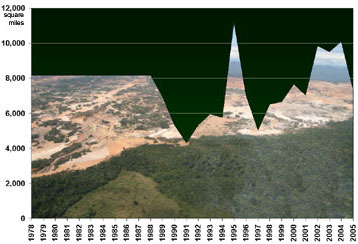Amazon to be logged sustainably says Brazil
Rhett A. Butler, mongabay.com
March 6, 2006
Last week Brazilian president Luiz Inacio Lula da Silva announced a plan to allow sustainable logging across 3 percent of the Amazon rain forest. The law is aimed at undermining destructive illegal logging activities—currently responsible for most of the commercial timber extraction in the region—while generating revenue for forest management and protection, and income for rural Brazilians in the region who often must rely on subsistence agriculture or employment on ranches and plantations under sometimes slave-like conditions.
By restricting licenses to private Brazilian companies, the new law will likely benefit both the domestic economy and local Amazon communities. In the past, foreign logging firms have operated in the Amazon with little regard to the environmental regulations, while illegal loggers have degraded large areas of forest, including those found in protected areas.
Typically, such logging reduces forest biodiversity while increasing the vulnerability of the forest to drought and wildfire. In 2005, a study by scientists at the Carnegie Institution of Stanford University found that “stealth logging“—selective logging that occurs under the protective canopy of forest trees—is responsible for damaging almost as much forest as is cleared in Brazil. Further, studies by the Environmental Defense Fund show that areas that have been selectively logged are eight times more likely to be settled and cleared by shifting cultivators than untouched rainforests because of access granted by logging roads. Logging roads give colonists access to rainforest, which they exploit for fuel wood, game, building material, and temporary agricultural lands.
President Lula hopes that sustainable forest management using “reduced impact logging” techniques can help mitigate these risks often associated with logging in tropical rainforests. Reduced-impact logging practices include: pre-harvest inventory and mapping of individual trees with commercial value; pre-harvest road and skid trail planning to prevent excess erosion; pre-harvest vine-cutting; directional tree felling to inflict the smallest impact on the surrounding forest; establishing stream buffer zones and watershed protection areas; using “yarding systems” to reduce damage to the soil caused by log extraction; reducing wood waste for cut areas (such as cutting stumps low to the ground); conducting a post-harvest assessment to provide feedback to concession holders. These steps can limit damage to the surrounding forest, cut erosion of topsoil, enable faster recovery of the forest, and reduce the risk of fire.

|
||||||||||||||||||||||||||||||||||||||||||||||||||||||||||||||||||||||
The long term nature (40-year concessions) of the contracts up for bid combined with requisite 5-year independent inspections of operations, means that timber firms will be held accountable for their logging practices. Monitoring and enforcement—including further crackdowns on illegal timber operators—will be funded by proceeds from the concession auctions.
While logging has played a part in the continuing loss of rainforest in the Amazon, most recent deforestation results from agricultural expansion, especially among cattle ranchers, large-scale soybean producers, and subsistence farmers. Since the close of the 1990s, deforestation rates of primary forest cover in Brazil have climbed by 35 percent while the Amazon has lost more than 132,000 square kilometers of rainforest.
In an effort to address forest clearing, the Brazilian government has set aside large tracts of forest as protected areas, including 26.4 percent of the Amazon basin as indigenous reserves. These protected areas have faced resistance from poor farmers, landowners, and developers, who have tried to fight the establishment of new parks and indigenous reserves and are known to illegally exploit forest resources—especially mahogany and other valuable timber—within the boundaries of protected areas. Nevertheless, a 2006 study conducted by researchers at the Woods Hole Research Center and the Instituto de Pesquisa Ambiental da Amazonia, found that parks and indigenous reserves in the Amazon help slow deforestation. Using quantitative analysis of satellite data, the research concluded that deforestation and the incidence of fires was significantly lower inside the perimeter of reserves and demarcated indigenous lands.
In his announcement, President Lula touted the new logging deal as an important step in breaking a long deadlock over how to deal with the Amazon Basin.
“Even up to a few years ago there was no real dialogue about the rainforest—it was war. One was either for the destruction of the rainforest, or considered the Amazon a sanctuary that was not to be touched,” he said.
Lula had faced criticism over his handling of Amazon deforestation. Last year his coalition government lost the support of the Green Party following the release of figures showing near record levels of deforestation for the 2003-2004 year when more than 26,000 square kilometers of forest were destroyed.
The biggest test facing the new agreement will be whether firms operate profitably in the Amazon without diminishing the resource base. If they can, it may open a new era for the sustainable management of tropical rainforests, the world’s most biodiverse ecosystems.